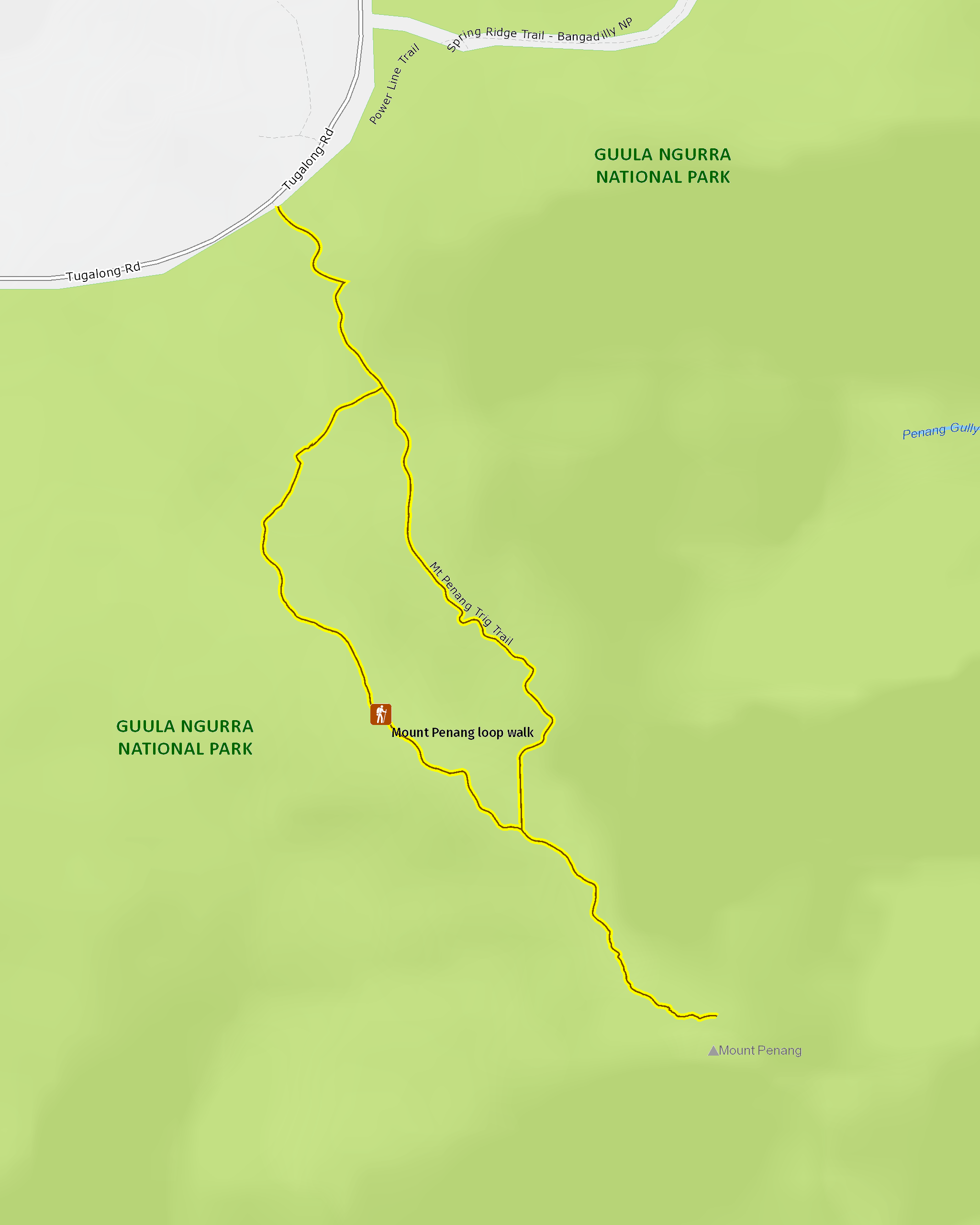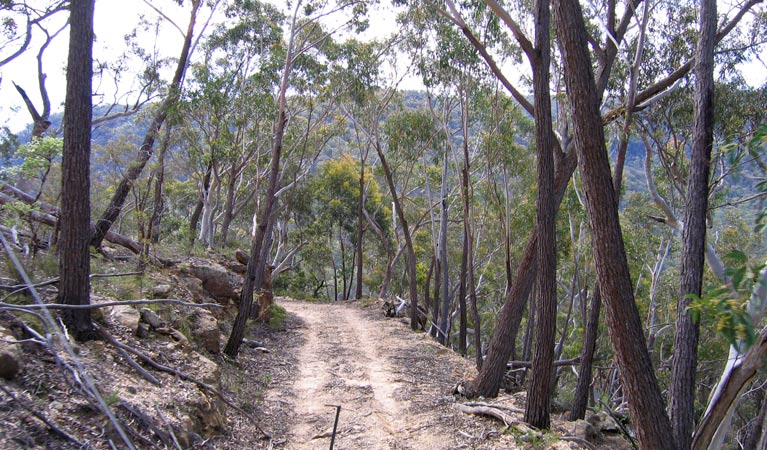Overview
Mount Penang loop walk in Guula Ngurra National Park is a 3km unmarked hiking trail that is best-suited to experienced bushwalkers.
- Where
- Guula Ngurra National Park in Country NSW
- Distance
- 3km loop
- Time suggested
- 2hrs 30min - 3hrs 30min
- Grade
- Grade 5
- Trip Intention Form
-
It's a good idea to let someone know where you're going. Fill in a trip intention form to send important details about your trip to your emergency contact.
- What to
bring - Drinking water, hat, sunscreen, compass, topographic map, gps
- Please note
- This park is in a remote location and weather can be unpredictable, so please ensure you’re well-prepared for your visit.
- If you’re bushwalking in this park, it’s a good idea to bring a topographic map and compass, or a GPS.
Mount Penang loop walk is only 3km, but you’ll need to be a relatively experienced bushwalker nonetheless, due to the short but steep hills and unmarked trail. The effort will be worth it though, as at the peak you’ll be able to enjoy soaking in some truly amazing 360-degree views from the summit of Mount Penang.
Beginning at Tugalong Road, this challenging but rewarding loop winds steadily uphill and continues on to the scenic summit of Mount Penang. Take in the awe-inspiring views from the top, savour the serenity of your surroundings, and look out for local birdlife soaring overhead before making your way back.
This walk is best enjoyed during the more temperate seasons of spring and autumn.
Also see
-

Baldy Billy Peak walking track
Climb to the top of Billy Baldy Peak on this steep and challenging 5km return walk in Guula Ngurra National Park, near Moss Vale and Canyonleigh.
Map

Map legend

Local alerts
For the latest updates on fires, closures and other alerts in this area, see https://www.nationalparks.nsw.gov.au/things-to-do/walking-tracks/mount-penang-loop-walk/local-alerts
General enquiries
- National Parks Contact Centre
- 7am to 7pm daily
- 1300 072 757 (13000 PARKS) for the cost of a local call within Australia excluding mobiles
- parks.info@environment.nsw.gov.au
Park info
- in Guula Ngurra National Park in the Country NSW region
Guula Ngurra National Park is open to the public but may be closed at short notice due to special operations, poor weather or fire danger.
Public vehicles are not permitted inside the park without consent to protect sensitive natural and cultural heritage values. Visitors to the Tugalong area must park outside the main gate.
Visitor info
All the practical information you need to know about Mount Penang loop walk.
Track grading
Features of this track
Distance
3km loop
Time
2hrs 30min - 3hrs 30min
Quality of markings
No directional signage
Experience required
Experienced bushwalkers
Gradient
Short steep hills
Steps
No steps
Quality of path
Formed track, some obstacles
Getting there and parking
Get driving directions
Mount Penang walk is in Guula Ngurra National Park. To get there:
From Sydney or Goulburn:
- Exit the freeway at Sutton Forest (exit signposted as 'Illawarra Highway - Moss Vale, Wollongong'). Follow the signs to Canyonleigh for 10km along Canyonleigh Road, then turn right into Tugalong Road. Travel 22km along Tugalong Road until you come to Attunga Camp on your left and the park on your right. Park at the entrance to the park fire trail and walk into the park.
Parking
Parking is available at the fire trail entrance on Tugalong Road.
Bus parking is available.
Best times to visit
There are lots of great things waiting for you in Bangadilly National Park. Here are some of the highlights.
Autumn
The cooler weather is a great time to hike up to Mount Penang and enjoy spectacular views out along the Wingecarribee River valley.
Spring
Spring is a great time to enjoy wildlife photography in the park and soak in all of the colourful plant life in full bloom.
Summer
Hang out along the cool riverbanks when the weather is hot, looking out for platypus in the stream and enjoying the shade of the tall forest gums.
Weather, temperature and rainfall
Summer temperature
Average
12°C and 26°C
Highest recorded
38.3°C
Winter temperature
Average
2°C and 13°C
Lowest recorded
-6.4°C
Rainfall
Wettest month
June
Driest month
September
The area’s highest recorded rainfall in one day
333mm
Facilities
Carpark
Maps and downloads
Prohibited
Pets
Pets and domestic animals (other than certified assistance animals) are not permitted. Find out which regional parks allow dog walking and see the pets in parks policy for more information.
Smoking
NSW national parks are no smoking areas.
Learn more
Mount Penang loop walk is in Guula Ngurra National Park. Here are just some of the reasons why this park is special:
Koala Country

The name Guula Ngurra was provided to the park by the Gundungurra People and translates as Koala Country. The park is part of the Gundungurra Indigenous Land Use Agreement (ILUA). The Wingecarribee and Wollondilly rivers that flow through the park, as permanent water sources and providers of diverse plant and animal resources, would have and continue to play an important role to the Aboriginal people. And the meeting point of the rivers, on the northern boundary of the park, is part of the Creation Story in which Mirragan fought Gurangatch, and is of great significance in Aboriginal culture.
- Wollondilly River walking track Wollondilly River walking track is a challenging 8km return walk in Guula Ngurra National Park, near Moss Vale. It's best suited to very experienced bushwalkers.
The boundary of 2 bioregions

Guula Ngurra National Park sits at the boundary of 2 bioregions. To the west is the South Eastern Highlands and to the east are the sandstone landscapes of Sydney Basin. Located on the boundary between these 2 bioregions, the park is high in biodiversity and supports species at their geographical limit.
The park also contains high quality koala habitat and sits within the Great Western Wildlife Corridor in the Southern Highlands, which supports an estimated population of 1000 koalas. The koala however is just 1 of 139 species of fauna the park supports and provides habitat for, 22 of which are listed as threatened.
Transformative rivers

Guula Ngurra National Park is home to 22km of the Wollondilly and Wingecarribee Rivers, including the point where they meet. These waterways have had a profound impact in shaping the park, carving out steep escarpments and rocky gullies that drop dramatically into the rivers’ valleys. Looking out over the valleys, Mount Penang and Baldy Billy Peak offer spectacular views and a glimpse into the rivers’ transformative history with the park.
- Baldy Billy Peak walking track Climb to the top of Billy Baldy Peak on this steep and challenging 5km return walk in Guula Ngurra National Park, near Moss Vale and Canyonleigh.
- Wollondilly River walking track Wollondilly River walking track is a challenging 8km return walk in Guula Ngurra National Park, near Moss Vale. It's best suited to very experienced bushwalkers.
Plants and animals protected in this park
Animals
-

Australian brush turkey (Alectura lathami)
The Australian brush turkey, also known as bush or scrub turkey, can be found in rainforests along eastern NSW. With a striking red head, blue-black plumage and booming call, these distinctive Australian birds are easy to spot while bird watching in several NSW national parks.
-

Common brushtail possum (Trichosurus vulpecula)
One of the most widespread of Australian tree-dwelling marsupials, the common brushtail possum is found across most of NSW in woodlands, rainforests and urban areas. With strong claws, a prehensile tail and opposable digits, these native Australian animals are well-adapted for life amongst the trees.
-

Common ringtail possum (Pseudocheirus peregrinus)
Commonly found in forests, woodlands and leafy gardens across eastern NSW, the Australian ringtail possum is a tree-dwelling marsupial. With a powerful tail perfectly adapted to grasp objects, it forages in trees for eucalypt leaves, flowers and fruit.
-

Bare-nosed wombat (Vombatus ursinus)
A large, squat marsupial, the Australian bare-nosed wombat is a burrowing mammal found in coastal forests and mountain ranges across NSW and Victoria. The only other remaining species of wombat in NSW, the endangered southern hairy-nosed wombat, was considered extinct until relatively recently.
-

Emu (Dromaius novaehollandiae)
The largest of Australian birds, the emu stands up to 2m high and is the second largest bird in the world, after the ostrich. Emus live in pairs or family groups. The male emu incubates and rears the young, which will stay with the adult emus for up to 2 years.
-

Koala (Phascolarctos cinereus)
One of the most renowned Australian animals, the tree-dwelling marsupial koala can be found in gum tree forests and woodlands across eastern NSW, Victoria and Queensland, as well as in isolated regions in South Australia. With a vice-like grip, this perhaps most iconic but endangered Australian animal lives in tall eucalypts within a home range of several hectares.
-

Kookaburra (Dacelo novaeguineae)
Of the 2 species of kookaburra found in Australia, the laughing kookaburra is the best-known and the largest of the native kingfishers. With its distinctive riotous call, the laughing kookaburra is commonly heard in open woodlands and forests throughout NSW national parks, making these ideal spots for bird watching.
-

Platypus (Ornithorhynchus anatinus)
One of the most fascinating and unusual Australian animals, the duck-billed platypus, along with the echidna, are the only known monotremes, or egg-laying mammals, in existence. The platypus is generally found in permanent river systems and lakes in southern and eastern NSW and east and west of the Great Dividing Range.
-

Red kangaroo (Macropus rufus)
The red kangaroo is one of the most iconic Australian animals and the largest marsupial in the world. Large males have reddish fur and can reach a height of 2m, while females are considerably smaller and have blue-grey fur. Red kangaroos are herbivores and mainly eat grass.
-

Short-beaked echidna (Tachyglossus aculeatus)
One of only 2 egg-laying mammals in the world, the short-beaked echidna is one of the most widespread of Australian native animals. Covered in spines, or quills, they’re equipped with a keen sense of smell and a tube-like snout which they use to break apart termite mounds in search of ants.
-

Wedge-tailed eagle (Aquila audax)
With a wingspan of up to 2.5m, the wedge-tailed eagle is Australia’s largest bird of prey. These Australian animals are found in woodlands across NSW, and have the ability to soar to heights of over 2km. If you’re bird watching, look out for the distinctive diamond-shaped tail of the eagle.
-

Yellow-tailed black cockatoo (Calyptorhynchus funereus)
The yellow-tailed black cockatoo is one of the largest species of parrot. With dusty-black plumage, they have a yellow tail and cheek patch. They’re easily spotted while bird watching, as they feed on seeds in native forests and pine plantations.
Plants
-

Grass tree (Xanthorrea spp.)
An iconic part of the Australian landscape, the grass tree is widespread across eastern NSW. These Australian native plants have a thick fire-blackened trunk and long spiked leaves. They are found in heath and open forests across eastern NSW. The grass tree grows 1-5m in height and produces striking white-flowered spikes which grow up to 1m long.
-

River red gum (Eucalpytus camaldulensis)
Australian native plants, majestic river red gum trees are widespread across Australian inland river systems. The river red gum is a dominant tree species of the Murray-Darling basin which spans NSW, Queensland and Victoria. This iconic native eucalypt grows to a height of 30m and is thought to have a lifespan up to 500-1000 years.

